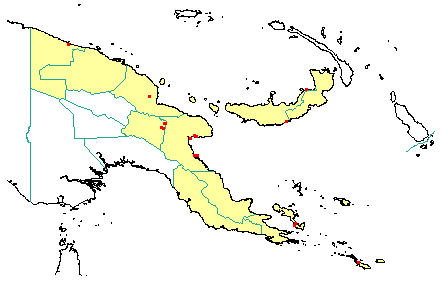
in PNGplants database
PNGTreesKey – Parinari papuana C.T.White |
Barry Conn (NSW) & Kipiro Damas (LAE).
Guide to trees of Papua New Guinea
Copyright held by the authors, National Herbarium of New South Wales, and Papua New Guinea National Herbarium
Journal of the Arnold Arboretum Vol. 31: 86 (1950)
Other Literature: G.T. Prance, Flora Malesiana, Series 1 658-659 (1989)
Family: Chrysobalanaceae
Dicotyledon
Timber Group: Occasional timber species
Field Characters: Large canopy tree (30-40 m high); Bole cylindrical (60-80 cm diam.); straight (bole c. 20 m long); buttresses buttresses present or buttresses absent; spines spines absent; aerial roots aerial roots absent; stilt roots stilt roots absent; Bark grey or brown, rough, finely fissured or scattered pustular; Subrhytidome (under-bark) red; bark blaze consisting of one layer; faintly to non-aromatic; outer blaze red or dark brown, markings absent; inner blaze red or dark brown, markings absent; bark exudate (sap) present, colourless, not readily flowing (spotty), colour not changing on exposure to air, not sticky or slightly sticky; terminal buds not enclosed by leaves.
Indumentum: Complex hairs absent; stinging hairs absent; mature twig indumentum (hairs) absent (coarsely pustular).
Leaves: Leaves spaced along branches, spiral (leaves occurring singly at a node and arranged spirally up the branchlet), simple (a leaf composed of a single blade); petiole present, not winged, attached to base of leaf blade, not swollen; leaves broadest at or near middle or slightly equally broad throughout much of length, 4.0-18.0 cm, 1.5-6.5 cm; symmetric, entire (with glands on lower surface of margin near base), not dissected or lobed, acuminate (shortly (acumen 3-20 mm long), venation pinnate, secondary veins open, prominent, intramarginal veins absent; leaves lower surface pale blue-green or pale green, upper surface dark green (glossy), indumentum (hairs) present (on lower surface in stomatal pits), indumentum (hairs) dense (inconspicuous); absent; domatia present (stomatal pits), scattered across lamina; stipules present, free, laterally placed, not encircling the twig, scale-like, not fringed, small (c. 1 mm long), not persistent.
Flowers: Inflorescence terminal (to sub-terminal), flowers on a branched axis, cones absent; flowers bisexual, stalked (shortly), flowers with many planes of symmetry, 3.0-6.0 mm long, diameter small (up to10 mm diam.) (c. 5 mm diam.); perianth present, with distinct sepals and petals whorls, inner perianth white, pale yellow, or cream-coloured; 5, free or some or partly joined (by misinterpretation: hypanthium appearing like a corolla tube); stamens 7-(with staminodes also present)-8, present, free of each other, free of the perianth or joined to the perianth (by misinterpretation: stamens joined to top of hypanthium together with petals); ovary superior, carpels joined (when more than one), locules 2; styles solitary, 1.
Fruits: Infrutescence arranged on branched axis, fruit 40.0-60.0 mm long, brown, not spiny (warty-rough), slightly non-fleshy or fleshy, simple, indehiscent, drupe; seeds 1-(1 per locule)-2, not winged, narrow (longer than wide).
Distribution: West Sepik, East Sepik, Madang, Morobe, Eastern Highlands, Central, Northern, Milne Bay, Papuan Islands & New Britain.
 | Botanical records in PNGplants database |
Notes: Notes The difference between Parinari papuana and Parinari nonda is unclear. G.T. Prance (1989) describes the leaf apex of Parinari nonda as acute or rounded, but never acuminate, with 10-17 pairs of secondary veins. Parinari papuana has a leaf apex that is acuminate (acumen 3-10 mm long) and 16-22 pairs of secondary veins. Prance regards the former species as a low tree of savannah forest and forest margins in the southern parts of the Western Province, with one collection from Milne Bay. Whereas, Parinari papuana is meant to be a large tree of rain-forest and hills. However, some tall trees from hill forest in the Papuan Islands with about 14 pairs of secondary vein-pairs, with acuminate leaves (acumen c. 5 mm long) are difficult to assign to either species. The amount of variation in the number of pairs of secondary veins is unknown.
G.T. Prance (1989) recognised two subspecies of Parinari papuana in Papua New Guinea (namely, subsp. papuana and subsp. whitei). These are not distinguished in this account of the Trees of Papua New Guinea.